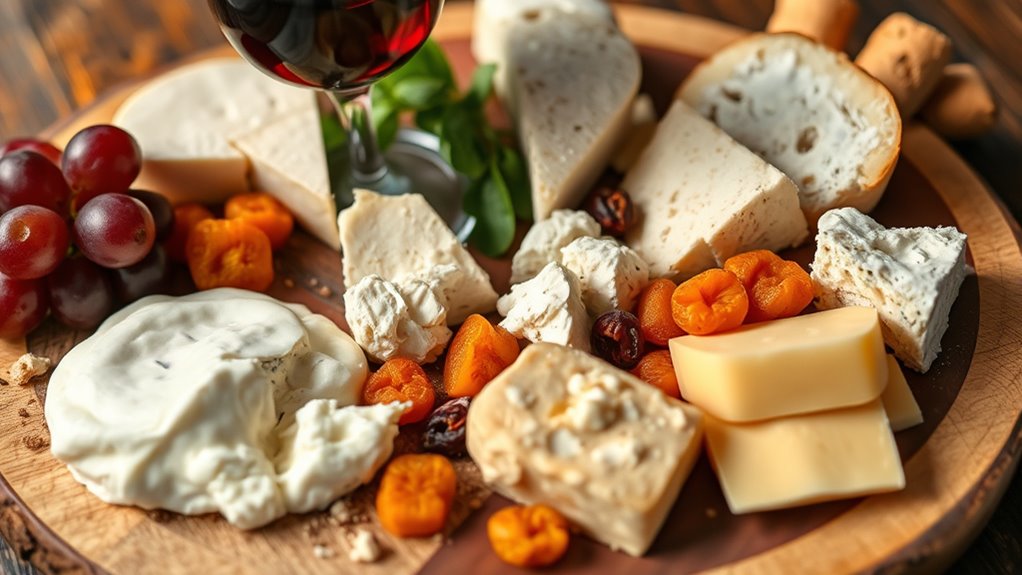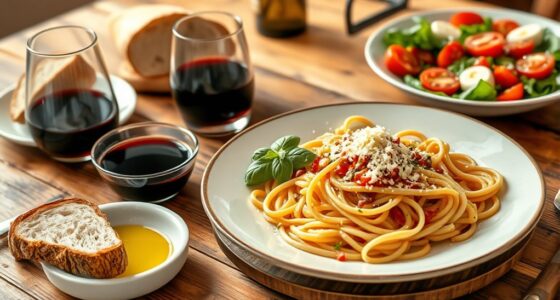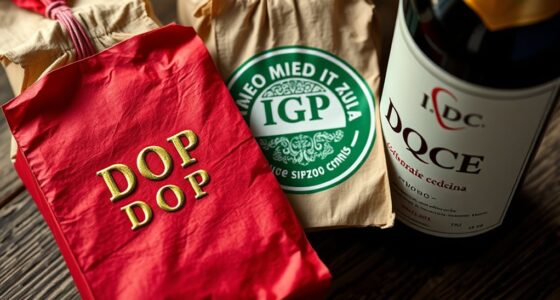To pair Italian cheeses with wine, consider the cheese’s texture and age. Soft, fresh cheeses go well with light, crisp wines like Pinot Grigio, while aged, hard cheeses match fuller-bodied reds such as Barolo. Blue or mold-ripened cheeses balance well with bold reds or fortified wines. Focus on matching acidity, tannins, and flavor intensity for harmony. Keep exploring each pairing to discover how different combinations elevate your tasting experience.
Key Takeaways
- Match soft, fresh cheeses with light, crisp wines like Pinot Grigio or Vermentino to enhance their delicate flavors.
- Pair aged, hard cheeses such as Parmigiano-Reggiano with full-bodied reds like Barolo for a balanced complexity.
- Combine blue or mold-ripened cheeses with bold reds or fortified wines to complement their pungency and saltiness.
- Consider wine acidity and tannins to counterbalance cheese saltiness and richness for harmonious pairings.
- Serve wines slightly chilled or at room temperature, and present cheeses attractively with accompaniments for an elevated tasting experience.
Understanding the Basic Types of Italian Cheeses
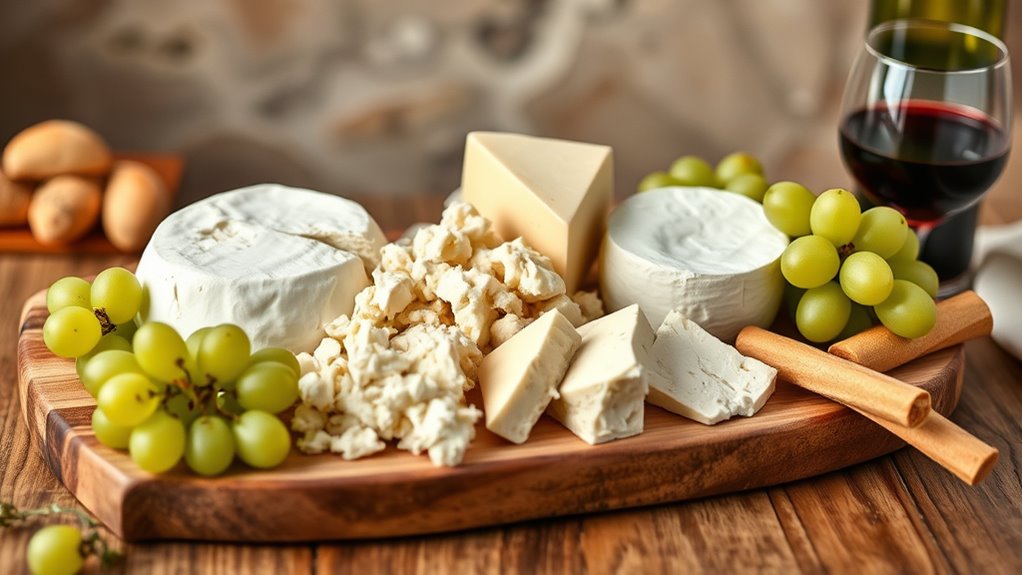
Have you ever wondered what makes Italian cheeses so unique and versatile for pairing with wine? It all begins with cheese aging and cheese textures. Young cheeses like mozzarella have a soft, delicate texture, making them perfect for light, crisp wines. As cheeses age, they develop more complex flavors and firmer textures, like Parmigiano-Reggiano’s granular consistency. Fresh cheeses are mild and moist, while aged cheeses become sharper and more crumbly. Understanding these differences helps you select the right wine to complement each cheese’s characteristics. Soft cheeses often pair well with sparkling or light white wines, whereas hard, aged cheeses match robust reds. Recognizing these basic types based on cheese aging and textures is key to creating harmonious pairings. Additionally, cheese production and technological innovations are influencing how cheese production is scaled and optimized, impacting the availability and consistency of various Italian cheeses.
Recognizing the Key Characteristics of Wines for Pairing
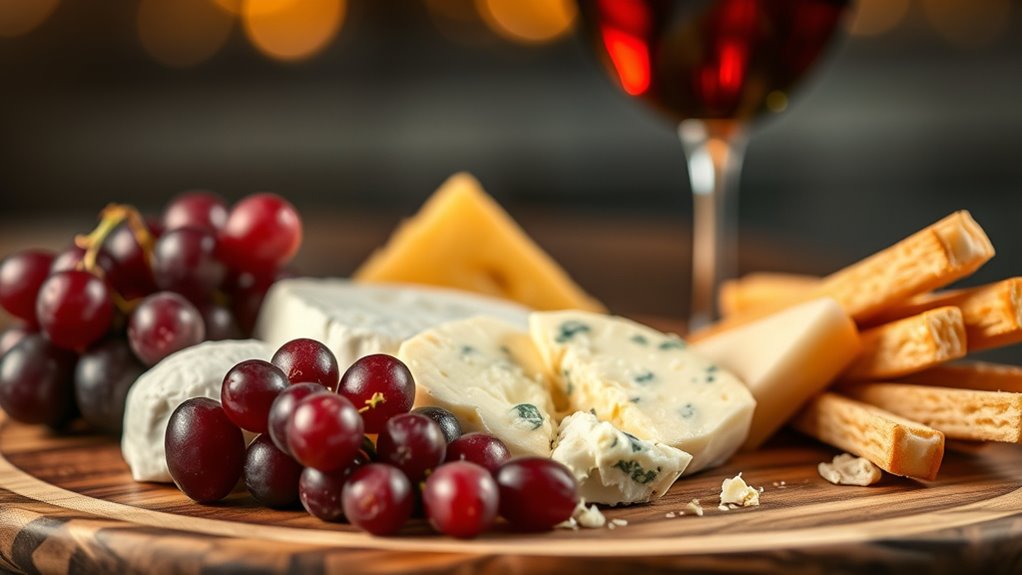
When selecting wines to pair with Italian cheeses, understanding their key characteristics helps you make better choices. Wine aromas reveal complex scents like fruity, floral, or earthy notes, which can enhance or contrast with cheese flavors. Additionally, consider the wine’s body and acidity—lighter wines with bright acidity pair well with delicate cheeses, while fuller-bodied wines complement richer textures. To refine your pairing, focus on these aspects: aromas: Match floral or fruity notes with softer cheeses, and earthy or spicy scents with stronger varieties. Cheese textures: Creamy cheeses need wines with enough acidity to cut through richness, while firm cheeses match with tannic reds. Wine body: Light wines suit delicate cheeses, whereas bold wines balance intense, aged varieties. Understanding the significance of zodiac sign compatibility can also offer insights into harmony and balance, similar to how selecting the right wine and cheese pairing creates a harmonious tasting experience.
Pairing Soft and Fresh Italian Cheeses With Light Wines
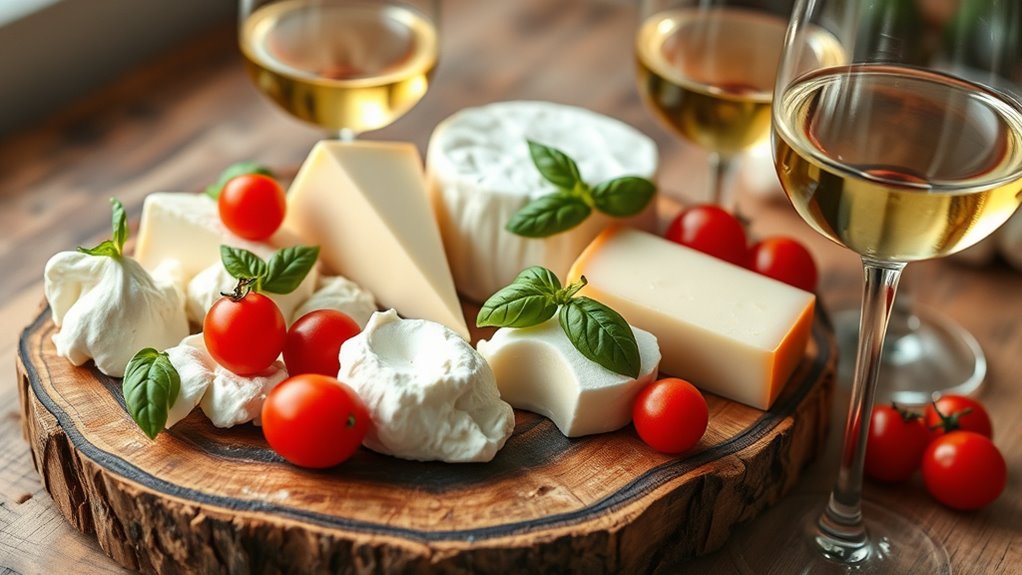
Pairing soft and fresh Italian cheeses with light wines creates a harmonious balance that highlights the delicate flavors of both. These cheeses, often minimally aged, have subtle, milky textures that pair best with wines that won’t overpower them. Light wines like Pinot Grigio or Vermentino complement the freshness by enhancing the cheese’s natural creaminess. Because these cheeses are young and have minimal cheese aging, they lack strong flavors, making them ideal for pairing with wines that have soft tannins or acidic profiles. Avoid heavy reds, which can clash with the cheese’s delicate profile. Instead, focus on wines that allow the cheese’s subtle notes to shine through, creating a fresh, balanced tasting experience. Incorporating mindful selection of wines ensures a more sustainable and responsible pairing that emphasizes quality over quantity. Additionally, choosing wines with gentle acidity can help elevate the natural brightness of these cheeses.
Matching Aged Cheeses With Rich, Full-Bodied Wines
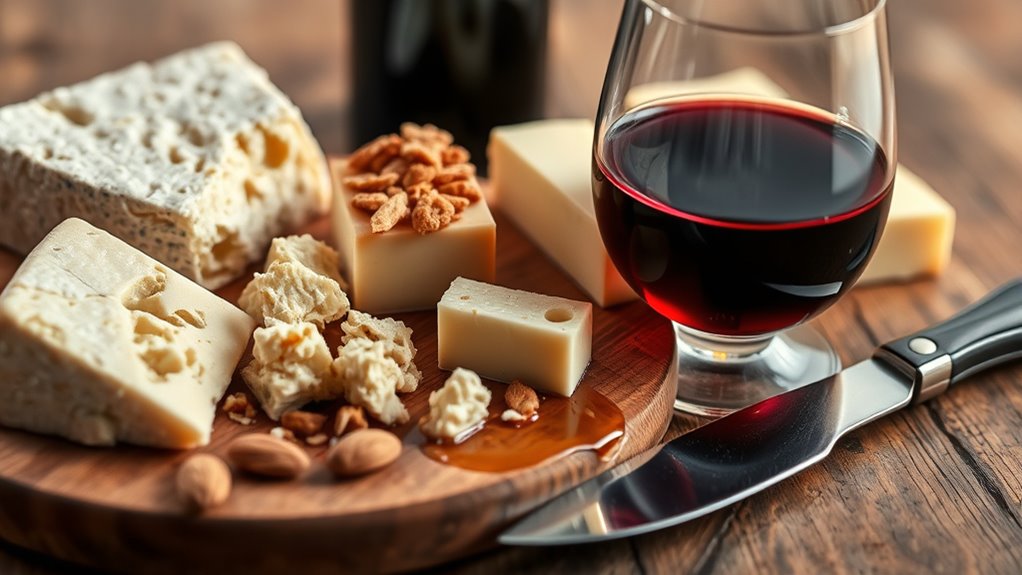
When pairing aged Italian cheeses with rich, full-bodied wines, you want to contemplate the balance of intensity and flavor. The wine should complement the cheese’s depth without overpowering it. Look for wines with similar profiles to create a harmonious and satisfying pairing. To ensure a successful match, consider the regulatory standards governing wine and cheese pairings to adhere to quality and authenticity. Additionally, understanding the flavor profiles of both cheeses and wines can help you select combinations that enhance each other’s qualities. For example, a robust Barolo pairs beautifully with aged Parmigiano-Reggiano, highlighting the importance of matching wine styles with cheese textures for optimal harmony. Incorporating tiny house designs and their innovative use of space can inspire creative presentation and serving options for your cheese and wine gatherings. Recognizing the sensory characteristics of each component can further elevate the pairing experience.
Intensity and Flavor Balance
Aged cheeses, with their complex textures and intense flavors, demand wines that can stand up to their richness. To achieve a proper flavor balance, consider these factors:
- Match cheese textures with wine weight—firm, crumbly cheeses work best with full-bodied wines.
- Balance flavor intensity—strong, pungent cheeses need wines with enough structure to complement rather than overpower.
- Pay attention to wine tannins—they should gently complement the cheese’s texture, avoiding harshness that can clash with creamy or crumbly textures.
- Incorporate knowledge of rustic decor elements to better understand how individual preferences may influence pairing choices and enhance the overall tasting experience.
- Remember that the vetted products and pairing guidelines help ensure a safe and enjoyable tasting, much like selecting trusted baby products for delicate skin.
- Considering the quality of ingredients in both cheese and wine can further refine the pairing, ensuring each element enhances the other harmoniously. Additionally, understanding dog breed dietary needs can help inform how certain flavors and textures might appeal to different palates, whether human or canine.
Complementary Wine Profiles
To complement the richness of aged cheeses, choose full-bodied wines with bold, layered profiles that can match their intensity. As cheese aging develops complex flavors, your wine should have enough structure and depth to balance the cheese’s richness. Wines with prominent tannins work well against the fatty, nutty notes of aged cheeses, creating a harmonious pairing. Consider the following options:
| Cheese Type | Ideal Wine Profile |
|---|---|
| Parmigiano-Reggiano | Rich reds with firm tannins |
| Pecorino Sardo | Full-bodied reds or robust whites |
| Gorgonzola | Sweet or fortified wines |
| Asiago d’Allevo | Bold reds with layered profiles |
Matching cheese aging with wine tannins enhances both flavors, producing a satisfying experience. Additionally, understanding the spiritual and emotional significance of auras can deepen your appreciation for the sensory experience of pairing. Exploring the mindfulness techniques involved in savoring these pairings can elevate your tasting experience and foster a deeper connection to the flavors. Incorporating vibrational energy into your tasting practices can also enhance your overall enjoyment and intuition during the pairing process. Engaging in sensory awareness can further refine your palate and enrich your appreciation of the intricate flavor combinations. Developing an awareness of the chemical interactions between cheese and wine can help you better understand why certain pairings work so well.
Combining Blue and Mold-Ripened Cheeses With Bold Wines
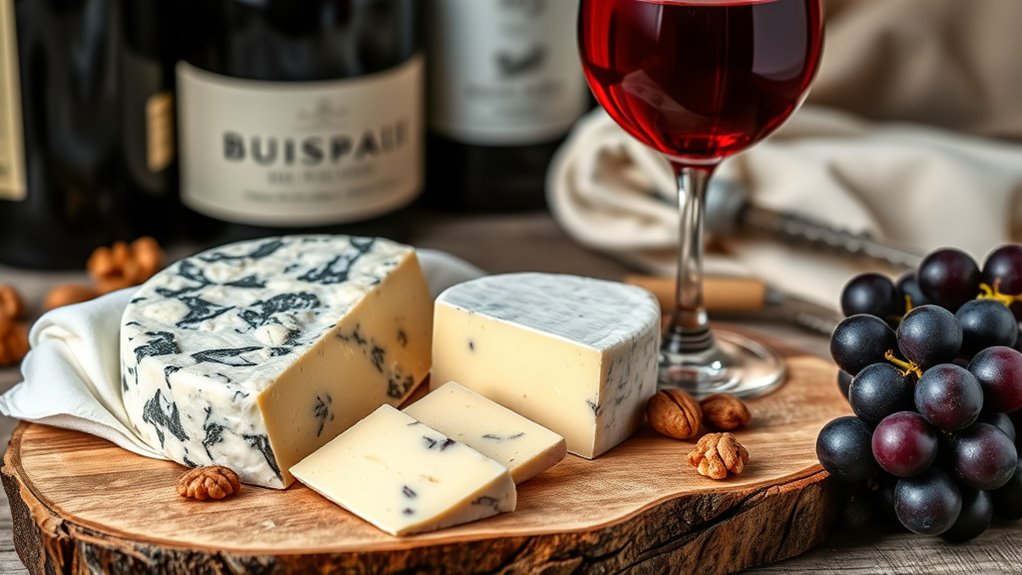
Blue and mold-ripened cheeses naturally demand bold wines that can stand up to their strong flavors. To enhance your pairing, consider these factors:
- Choose wines with firm tannins, which balance the cheese’s pungency and cut through its richness.
- Opt for wines with some age, as cheese aging intensifies flavors, requiring a wine with enough structure.
- Look for bold reds or fortified wines that complement the cheese’s mold and blue veining without overpowering it.
- Remember that the market volatility of gold can influence the value of your investments, highlighting the importance of choosing stable, reputable options when selecting your wine pairings.
- The structure of the wine, including its acidity and tannins, plays a crucial role in creating a harmonious pairing with these cheeses.
- Additionally, understanding the vulnerabilities of AI models can help in selecting wines that maintain their integrity when paired with such rich cheeses, ensuring a balanced and enjoyable experience.
The tannins in bold wines help mellow the cheese’s saltiness while adding complexity. Remember, pairing these cheeses with robust wines creates a harmony that elevates both, especially when considering the cheese’s aging process and the wine’s bold tannins.
Tips for Balancing Saltiness and Acidity in Pairings
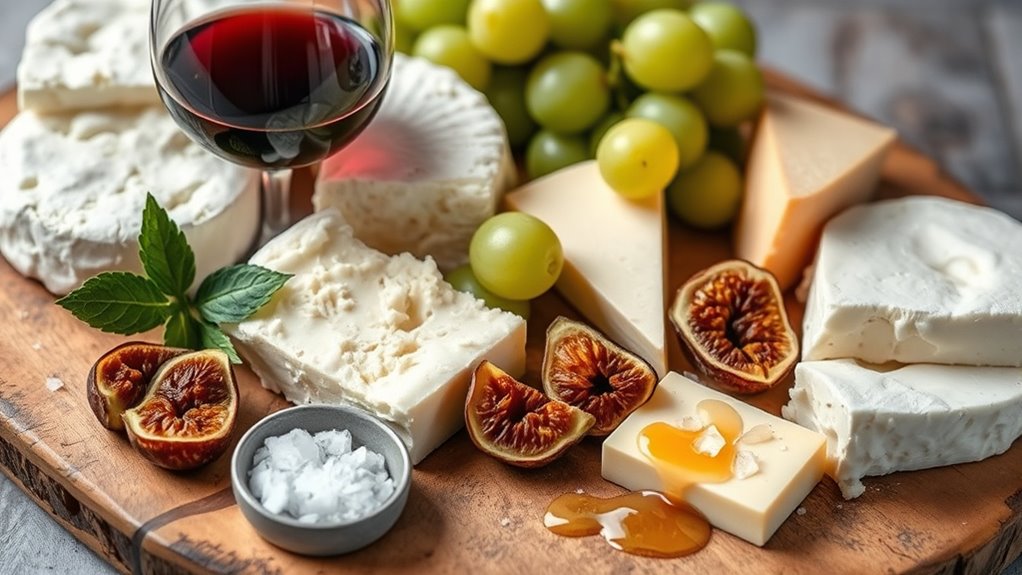
Balancing saltiness and acidity is essential for creating harmonious cheese and wine pairings. To achieve the right saltiness balance, choose wines with enough freshness and acidity to cut through the cheese’s saltiness without overpowering it. Acidic wines, like a crisp Pinot Grigio or a lively Vermentino, work well to provide an acidity complement that refreshes your palate. When pairing, consider the cheese’s salt level and acidity; if the cheese is particularly salty, opt for wines with higher acidity to balance the flavor. Conversely, if the cheese has a milder saltiness, a softer, less acidic wine can enhance the pairing. The goal is to create a synergy where the wine’s acidity and the cheese’s saltiness enhance each other without clashing.
Classic Italian Cheese and Wine Combinations to Try
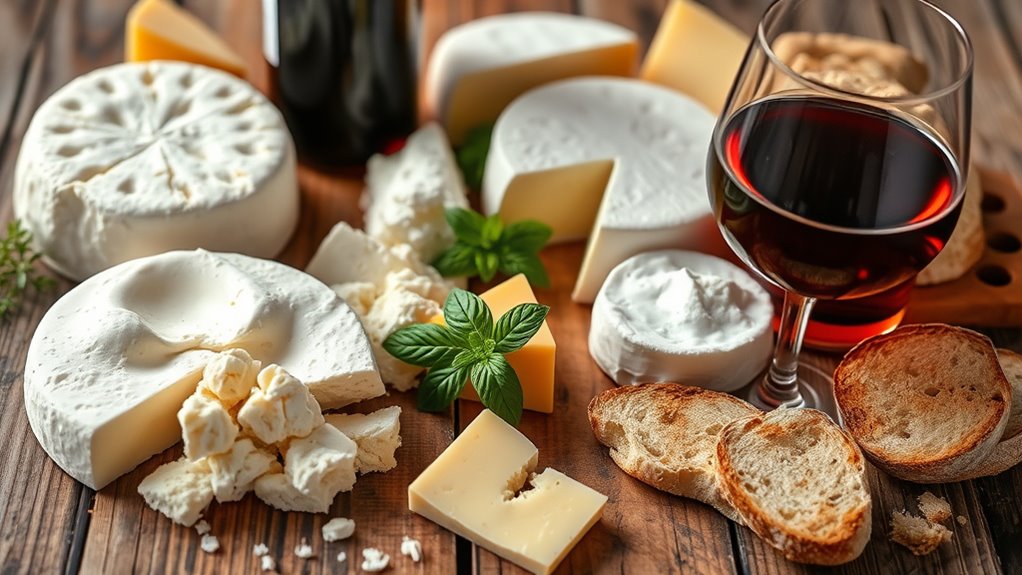
Italian cheeses and wines have long been paired to highlight their unique flavors, creating harmonious combinations that elevate any culinary experience. For classic pairings, consider these options:
Italian cheeses and wines are perfectly paired to enhance their distinctive flavors.
- Parmigiano-Reggiano with full-bodied reds like Barolo, where cheese aging enhances nutty flavors that complement wine tannins.
- Gorgonzola with sweet dessert wines such as Sauternes or Moscato, balancing mold-ripened cheese’s creaminess with fruity sweetness.
- Pecorino Romano with robust reds like Chianti, where the cheese’s saltiness and aging process contrast nicely with the wine’s acidity and tannins. These combinations showcase how cheese aging and wine tannins interplay, creating depth and complexity in every bite and sip.
Creative Pairing Ideas for Modern Italian Cheeses and Wines
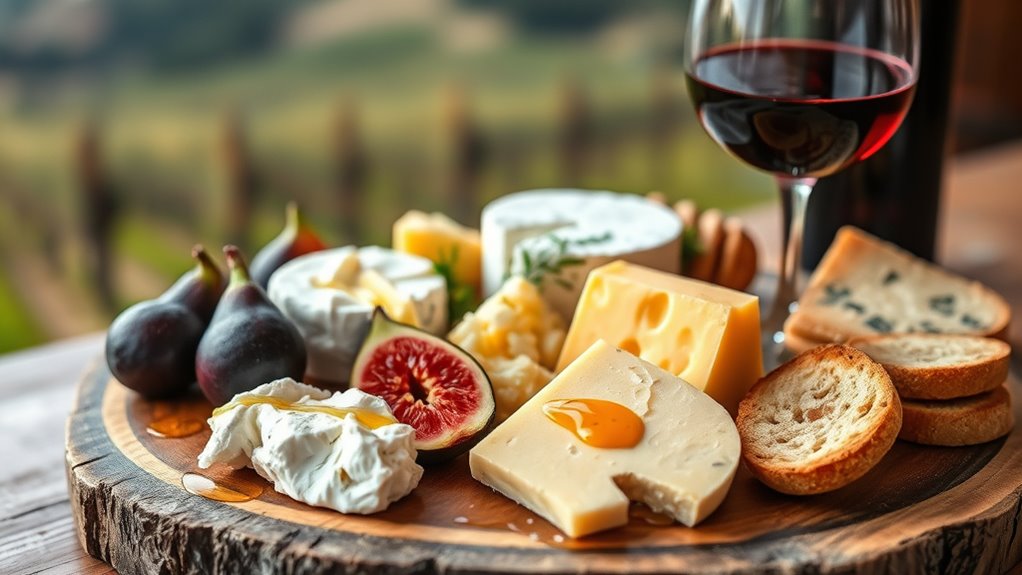
While traditional pairings focus on classic combinations, exploring modern Italian cheeses opens up exciting opportunities for creative wine matches. Modern cheeses often feature unique cheese aging processes, resulting in diverse textures and flavors that challenge conventional pairings. For instance, a young, fresh cheese with a mild profile pairs well with light white wines, while a more aged, crumbly cheese can stand up to wines with robust tannins. When pairing, consider how wine tannins interact with cheese’s saltiness and acidity, especially in cheeses undergoing cheese aging. Experimenting with bold, contemporary cheeses like smoked or infused varieties allows you to explore unexpected pairings, highlighting the cheese’s complexity and revealing new dimensions in both the wine and cheese experience.
Serving and Presentation Tips for the Perfect Pairing Experience
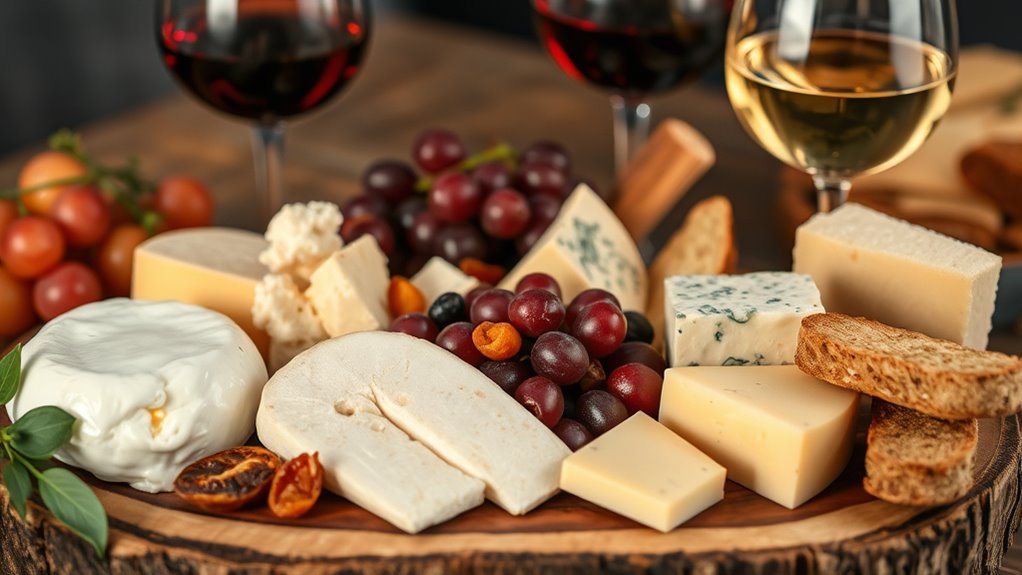
To create the perfect pairing experience, proper serving and presentation are essential. Focus on cheese presentation by arranging cheeses attractively on a wooden board or platter, allowing each type to stand out. Guarantee the wine serving temperature is ideal—serve whites slightly chilled and reds at room temperature to enhance flavors.
For a memorable pairing, arrange cheeses attractively and serve wines at optimal temperatures to enhance flavor harmony.
Here are three tips to elevate your presentation:
- Use cheese knives for each variety to prevent cross-flavor contamination.
- Label cheeses and wines clearly for a sophisticated look.
- Accompany the display with complementary elements like fresh fruits, nuts, and artisan bread.
These small touches improve visual appeal and flavor harmony, making your Italian cheese and wine pairing truly memorable.
Frequently Asked Questions
How Do Regional Differences Affect Cheese and Wine Pairings in Italy?
Regional differences in Italy influence cheese and wine pairings considerably. You’ll find that regional cheese varieties, like Gorgonzola in the North and Pecorino Romano in the South, are best paired with local wine traditions. These combinations highlight the unique flavors of each area. By exploring local cheeses and matching them with regional wines, you’ll enjoy authentic, harmonious pairings that reflect Italy’s diverse culinary heritage.
What Are the Best Serving Temperatures for Italian Cheeses and Wines?
Imagine you’re a 16th-century noble, yet today, you control cheese storage and wine temperature with modern ease. For ideal flavor, serve Italian cheeses like Parmigiano-Reggiano at around 60-65°F, slightly below room temperature. Fresh cheeses like mozzarella chill at 45-50°F. Wine temperature control is key—red wines like Chianti shine at 60-65°F, while whites such as Pinot Grigio are best chilled at 45-50°F. Proper serving temps enhance your tasting experience.
Can Non-Italian Wines Complement Traditional Italian Cheeses Effectively?
You can definitely enhance your cheese experience by exploring international wines with traditional Italian cheeses. Non-Italian wines often bring unique flavor profiles that complement the cheese’s richness and texture. By considering the cheese’s flavor profile—such as sharpness, creaminess, or nuttiness—you can select an international wine that balances or enhances those qualities, creating a delightful pairing that broadens your tasting horizons and elevates your cheese platter.
How Do Aging Processes Influence Pairing Choices for Italian Cheeses?
Imagine aging processes transforming cheeses into flavor powerhouses—this aging impact can make or break your pairing. When selecting wines, consider how the cheese’s age influences its flavor profile and texture. Young cheeses are fresh and mild, demanding lighter wines, while aged cheeses develop intense, complex flavors that match bold wines. Your goal is perfect flavor compatibility, balancing the cheese’s maturity with the wine’s depth for an unforgettable tasting experience.
Are There Specific Glassware Recommendations for Enhancing Cheese and Wine Pairings?
When choosing cheese glassware, you wanna focus on wine glass shapes that enhance the flavors. Use a wider bowl for full-bodied reds to let aromas develop, and a narrower glass for whites to keep their crispness. Proper cheese glassware helps balance textures and intensifies taste. By selecting the right wine glass shapes, you’ll elevate your pairing experience and truly enjoy the nuanced flavors of Italian cheeses.
Conclusion
Now that you know the dance between Italian cheeses and wines, let your palate be the choreographer. Imagine each sip and bite as a harmonious melody, where flavors swirl and mingle like a well-orchestrated symphony. Trust your instincts, experiment with bold and subtle pairings, and turn every cheese board into a vibrant tapestry of taste. With a little confidence, you’ll craft unforgettable moments that dance off the plate and into your memory.
